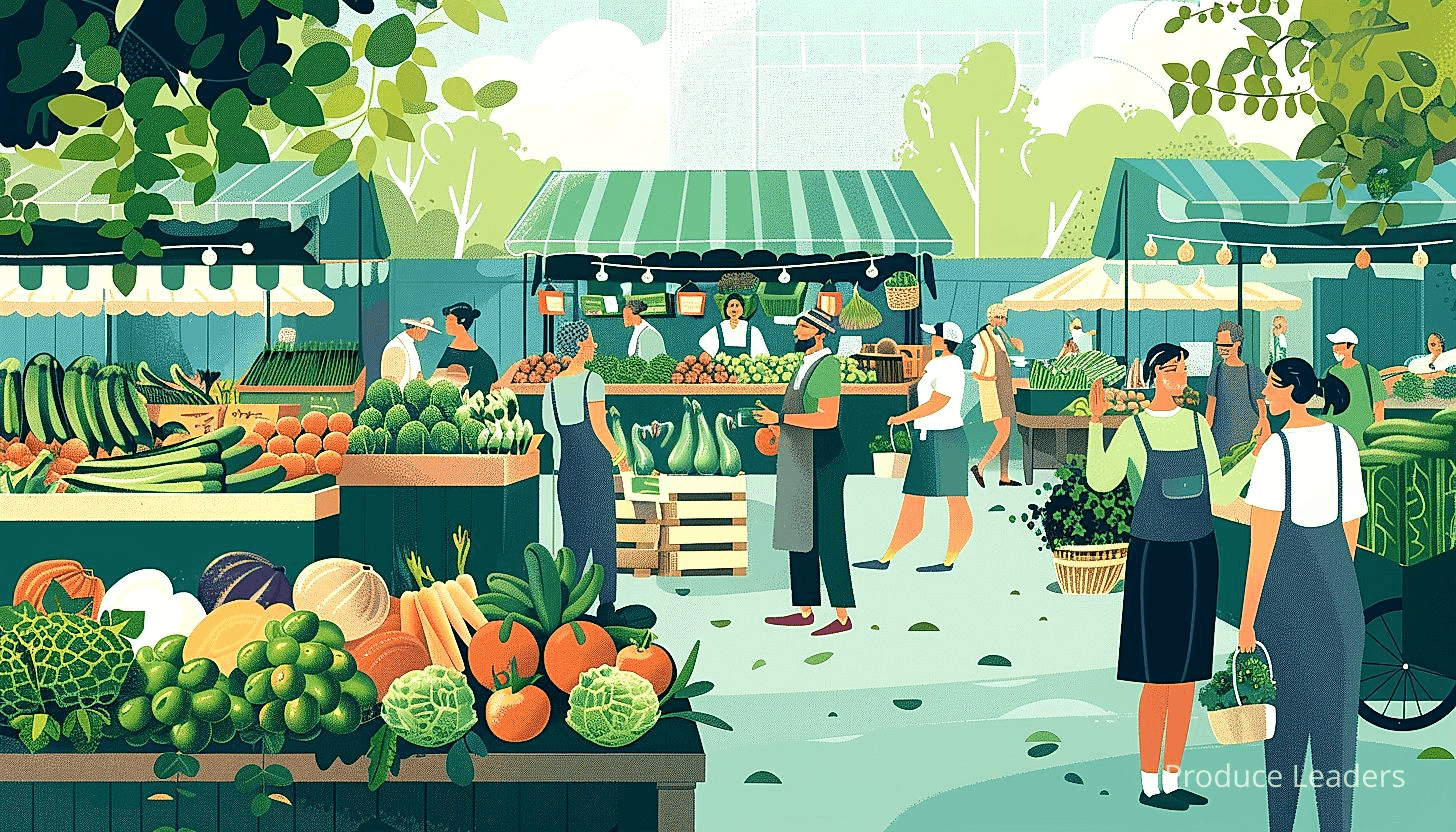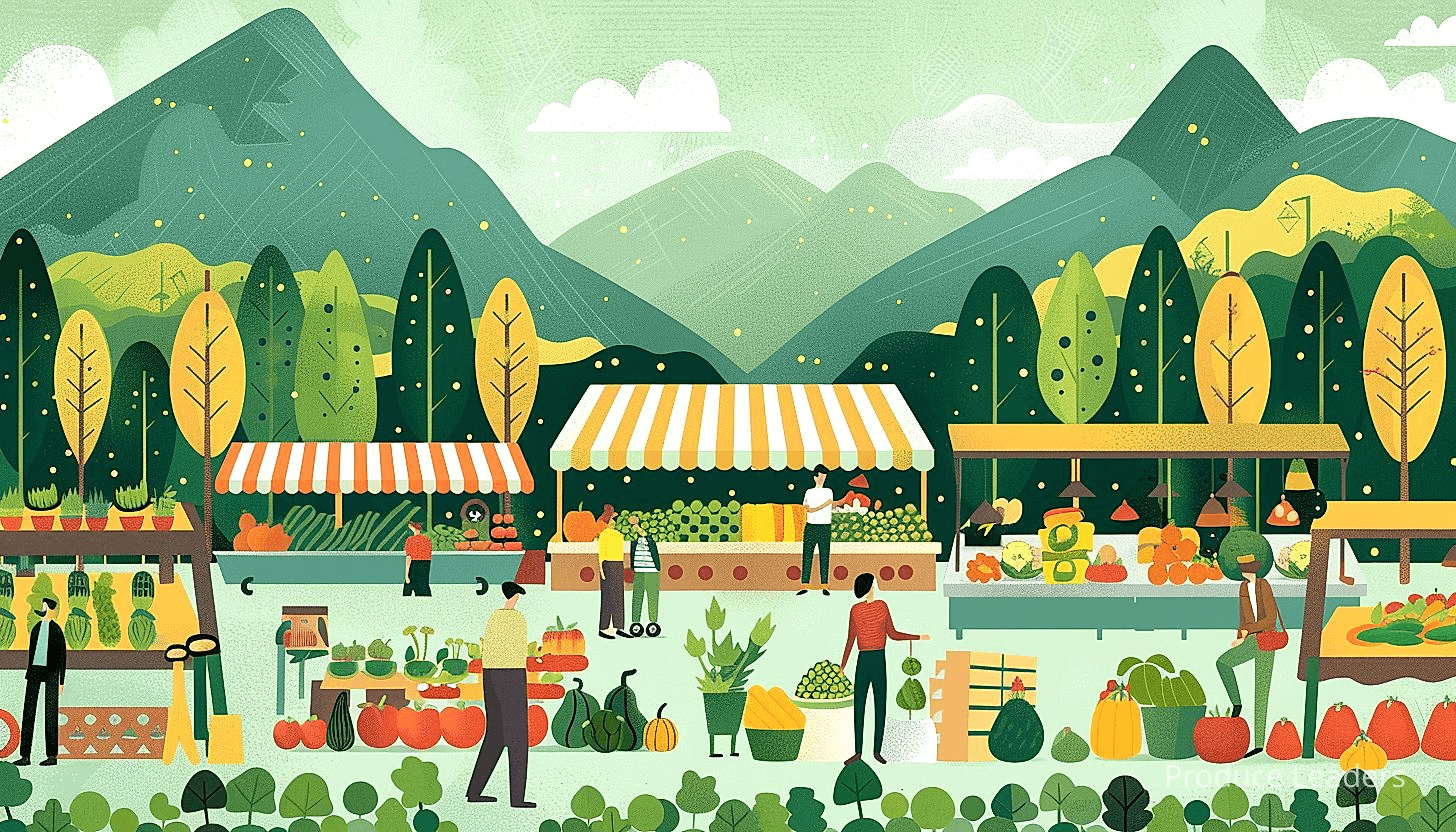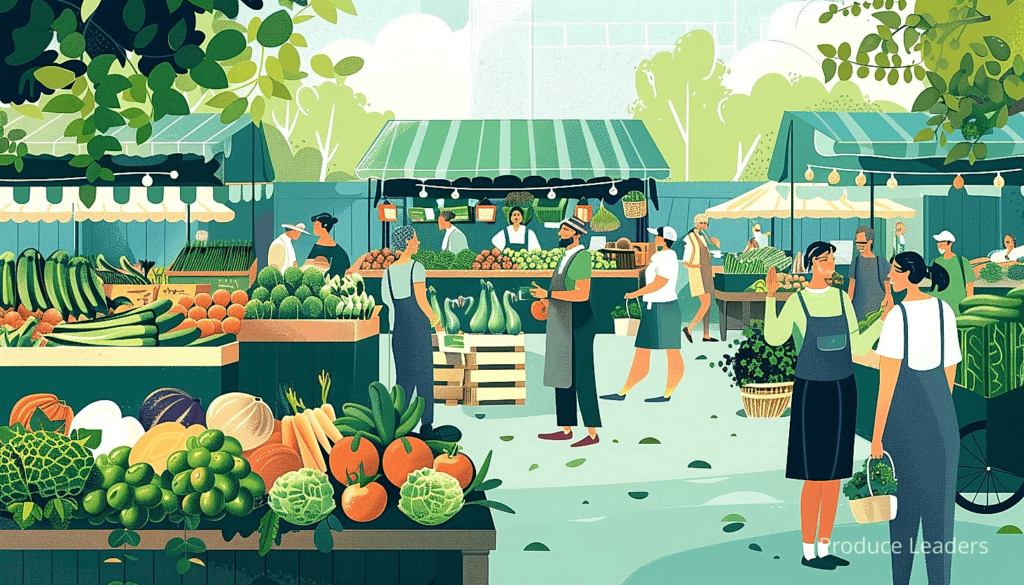Co-op marketing in the produce industry can be the silver bullet for growth and sustainability.
However, its success greatly depends on strategic planning, transparency, and effective collaboration.
In a dynamic landscape where preferences shift constantly, finding the right partners can make all the difference.
This not only enhances productivity but also creates value for your customers.
Over the years, many companies have failed at this, while others have found unprecedented success.
Let’s dive into the fundamental strategies and methodologies behind successful co-op marketing in the produce arena.
- Establish clear expectations and marketing goals.
- Strengthen relationships between farmers and retailers.
- Emphasize on the promotion of local and organic produce.
- Implement effective communication strategies.
- Provide competitive pricing, incentives and excellent customer service.
While these key takeaways provide valuable insight, there is more depth to explore in the realm of co-op marketing in the produce industry.
In the following sections, we explore additional related topics that provide a broader understanding of our subject matter. This expanded knowledge will equip you in making more informed decisions in your co-op marketing strategies and plans.
We will also uncover and break down more complex aspects of co-op marketing. This will ensure you have a comprehensive understanding and can effectively apply these principles within your business.
Stay tuned as we dig in further into these key components of co-op marketing and how they can contribute to your continued success in the produce industry.
Contents
- Secrets To Successful Co-op Marketing In Produce
- 1. Establish Clear Expectations and Goals
- 2. Strengthen Farmer and Retailer Relationships
- 3. Promote Local and Organic Produce
- 4. Implement effective communication strategies
- 5. Offer Competitive Pricing and Incentives
- 6. Provide Excellent Customer Service
- 7. Maintain consistent product quality and availability
- The Bottom Line
Secrets To Successful Co-op Marketing In Produce
1. Establish Clear Expectations and Goals
In Short: Successful co-op marketing in produce requires defined expectations, goals, and a concrete plan, steering businesses towards desired profitability, market dominance, and sustainability. It’s essential to build capacities, form relationships, allocate adequate funding, carve a unique brand identity, set and track SMART goals, and adapt to ever-changing market dynamics.
Opening one’s mind to the world of co-op marketing in produce requires a steadfast commitment to establishing clear expectations and goals. Having clarity about what you want to achieve is the first, essential step before diving in.
One must acknowledge that the road is filled with daunting challenges, but with resilient determination and a clear vision, these can be merely stepping stones toward achieving the objective.
The pathway leading toward co-op marketing success isn’t a casual stroll. It demands a concrete plan sculpted by well-defined expectations and goals.
Company leaders and stakeholders must be on the same page about these expectations and goals. It’s not just the decision-makers, but everyone involved in the business operation should have a clear interpretation of the direction they want to move.
Profitability, sustainability, market dominance are among some of the reasons businesses turn to co-op marketing. These guide businesses to make informed strategic decisions.
Part of establishing these expectations involves understanding the broader market landscape, consumer demands, and the potential opportunities that can be leveraged. Knowledge about the current market trends and future projections can be very resourceful in this regard.
This is to help present the baseline that sets the initialization point of our next key strategies. Here are some strategic areas of interest that any produce marketing organization can pivot towards:
- Capacity building: Enhancing the skills of existing teams to match the demands of the evolving marketing landscape.
- Relationship building: Creating and nurturing relationships with key stakeholders like farmers, suppliers, and consumers.
- Funding: Ensuring the finances and budget match the aspirations of the business.
- Brand positioning: Carving a unique identity that sets the business apart in the crowded market.
All goals need to be SMART (Specific, Measurable, Achievable, Realistic, and Time-bound). This approach helps in quantifying the objectives and providing a clear trajectory towards achieving them. Sight of achievable goals can motivate and ignite the passion within the workforce to work harder.
But it doesn’t end at just setting goals. There must be an effective system in place to monitor progress and measure success against the established objectives. This real-time tracking ensures that necessary course corrections can be implemented promptly, keeping the forward momentum.
Failure to meet goals shouldn’t deter businesses but should be taken as a learning curve. Understanding the causes helps prevent future mishaps and builds resilience.
In this gauntlet of competition, it’s not just about survival, but prospering, and setting among others, clear expectations and goals is the secret to not only navigating this labyrinth but coming out victorious.
And remember that these goals don’t have to be set in stone. As the business evolves and expands, these goals may shift and change , and that’s completely fine. It’s essential to allow room for flexibility and adaptation as the market dynamics continue to transform.
Let me tell you, let us all take the first step towards a successful co-op marketing venture by firmly standing on the rock of clear expectations and goals.
2. Strengthen Farmer and Retailer Relationships
In Short: Strengthening farmer and retailer relationships plays a significant role in boosting the efficiency and sustainability of the supply chain through increased cooperation and mutual understanding. By sharing resources, understanding each other’s goals and struggles, and implementing technology like blockchain for transparency, this bond not only improves business outcomes in produce co-op marketing, but also contributes to a more sustainable and resilient food system.
For a successful co-op marketing strategy in produce, strengthening farmer and retailer relationships is of pivotal importance.
Nurturing this bond can create an environment of mutual support and respect, fostering a productive and profitable business atmosphere.
It’s a proven fact that strong partnerships between farmers and retailers can boost the efficiency and sustainability of the supply chain.

Farmers and retailers can collaborate by sharing their resources, knowledge, and capabilities, which can ultimately lead to more robust outcomes.
Establishing strong relationships with farmers is not just about the business aspect, but it also involves understanding their struggles, aspirations, and what motivates them to produce the best quality crops.
Retailers, on the other hand, need to comprehend that they have a social responsibility to treat farmers fairly and ethically.
Open dialogues and regular interactions can help improve relationships and facilitate better mutual understanding.
One effective way to strengthen these relationships is through various coordination efforts such as:
- Joint Marketing Campaigns: Pooling resources for an impact-oriented marketing strategy.
- Sharing of Knowledge and Best Practices: This empowers both parties with the right resources and skills.
- Establishment of an Effective Communication Channel: To ensure all parties are kept in the loop with relevant and timely information.
The introduction of technology can also ease operations and improve collaboration. For instance, the use of blockchain technology can provide transparency and greater efficiency in the supply chain process.
In turn, this can give rise to stronger and more faithful relationships between farmers and retailers, which is beneficial for both parties.
A stronger relationship between farmers and retailers enables improved cooperation in problem-solving and decision-making, resulting in better business outcomes.
This also manifests into trust and respect which are cornerstones for any successful relationship.
Pro Tip: Strengthening the relationships between farmers and retailers is critically important for a successful co-op marketing strategy in produce, as it can enable improved cooperation, enhance communication, optimize efficiency and sustainability in the supply chain, and even contribute to a more resilient food system.
Certainly, stronger farmer and retailer relationships serve as a solid foundation to attain the ultimate goal of a successful co-op marketing in produce.
In the grand scheme of things, these strengthened relationships not only elevate business prospects but also contribute to a more sustainable and resilient food system.
3. Promote Local and Organic Produce
In Short: Promoting local and organic produce is a key strategy for co-op marketing success, fostering community support and customer loyalty. Using informative signage, hosting farmer meet-ups, and sharing farmers’ stories via social media are effective ways to educate consumers and highlight the values of sustainable, local sourcing.
When thinking about strategic approaches to co-op marketing in the produce industry, one of the pivotal methods that should be in your arsenal is the promotion of local and organic produce.
In current times, consumers are more conscious about their food choices than ever before, and supporting local farmers and choosing organic options are increasingly important considerations for many.
Promoting local and organic products not only builds relationships with nearby growers and suppliers, it also strengthens community support and fosters a sense of loyalty among your customers.
Without a doubt, local and organic produce often comes with a story, the story of passionate individuals dedicated to raising nutritious and delicious fruits and vegetables in a sustainable way.
The next step in effectively promoting this type of produce involves sharing these stories with your customers.
This strategy can often be more impactful than other promotional techniques, as it allows shoppers to feel connected to the food they eat, and to the people who grow it.
The key here is to create a narrative that individuals will not only value, but also think about during each shopping trip.
To effectively promote local and organic produce, consider following these steps:
- Informative signage and labels: Not all customers might be familiar with the difference between local, organic, and conventional produce. Use clear and straightforward signage and labels to educate your shoppers.
- Meet the farmer events: Hosting occasional events where customers can meet and interact with local farmers can go a long way in fostering relationships and education.
- Utilize Social Media: Take advantage of your online platforms to share stories, pictures, and videos of local farmers and their work. This not only increases visibility for the farmers but also fosters a sense of community among your customers.
With these tactics in mind, you would be on a journey towards effectively promoting local and organic produce, which in turn would contribute to overall co-op marketing success.
It’s also important to understand that the promotion of local and organic produce is something that grows with time.
While it may initially seem as a slow process, the cumulative impact of these efforts can yield high returns in the long run, both in terms of customer loyalty and sustainability.
Though it might seem like a lot of extra work, the benefits of promoting local and organic produce far outweigh the drawbacks.
When done right, promotion of local and organic products can solidify your place in the market as an ethical, trusted, and progressive retailer.
The key is commitment, perseverance, and a strong connection to the community to which you’re looking to serve.
4. Implement effective communication strategies
In Short: Effective communication strategies are vital in cooperative marketing; that involves understanding stakeholder needs, consistent communication, and crafting relatable messages. Remember, communication isn’t just about delivering a message but also fostering relationships and driving your marketing success.
In the context of cooperative marketing in the produce sector, effective communication strategies are instrumental in ensuring success.
Marketing cannot happen in a vacuum and thus, proper channels for relaying information must be established.
At the very core of this process is the need to understand and address the needs of each stakeholder involved, whether it be the farmers, retailers, or end consumers.

Transparent and consistent communication builds trust, fosters robust relationships, and encourages active participation.
Considering the diverse audience involved in cooperative marketing, crafting a message that will resonate with everyone is a daunting yet necessary task.
It’s essential to tailor your approach depending on who you are communicating with, bearing in mind their specific concerns and expectations.
This strategy involves not only the content of the message but also the mode and frequency of communication.
Before diving into specific communication strategies, there are several universal principles that should guide this endeavor:
- Treat every stakeholder as an essential part of the process.
- Listen to feedback and make necessary adjustments based on this.
- Always be clear and concise with your message.
With these principles in mind, a more targeted approach can now be applied to each group of stakeholders.
Farmers need to be constantly updated on pricing, demand trends, and other market information.
Consumers, on the other hand, value information on product quality, sourcing, and the benefits of supporting local agriculture.
Pertaining to the retail realm, communication should revolve around logistics, pricing, and promotional strategies.
A successful co-op marketer understands the unique needs of each group, capitalizing on them to establish effective communication.
Always remember, the aspiration here is not only to deliver a message but also to build relationships, understand needs, and ultimately, drive the success of your marketing efforts.
5. Offer Competitive Pricing and Incentives
In Short: Boosting co-op marketing efforts relies on offering competitive pricing and incentives, emphasizing the best value, not necessarily the lowest price. Co-ops stand apart by supporting local farmers, providing quality produce and excellent customer service, while also offering customer rewards and discounts to enhance loyalty.
A critical component in boosting your co-op marketing efforts in produce lies in offering competitive pricing and incentives.
It’s undeniable that price plays a significant role in a consumer’s decision-making process.
Consumers are often willing to pay more for goods if they perceive them to offer better value for their money.
This means, competitive pricing isn’t always about being the cheapest, but more about offering the best value.
A co-op could offer produce at a price that’s competitive with other local or large-scale stores while ensuring excellent service and product quality.
This way, a customer doesn’t feel as if they are having to compromise on quality for the sake of price.
On the topic of value, let’s talk about a few ways that co-ops stand apart from other stores and offer additional value:
- Support for local farmers: Co-ops prioritize purchasing from local farmers, contributing to local economy growth.
- High-quality produce: With a direct line to local farmers, the quality of the organic produce found at co-ops is often higher compared to large-scale stores.
- Customer service: Co-ops often emphasize excellent customer service, making for a better shopping experience.
- Community involvement: Co-ops contribute to their communities, often participating in events and initiatives to give back.
While these value propositions are compelling on their own, coupling them with competitive pricing can yield even better results in winning over shoppers.
Another commodity to also consider alongside competitive pricing is the use of incentives.
Offering promotions or benefits to shoppers who consistently choose your co-op can greatly enhance customer loyalty.
For instance, a customer rewards program or occasional discounts on bulk purchases can serve as a powerful incentive to keep customers returning.
Pro Tip: Offering both competitive pricing and desirable incentives in your co-op not only makes it an attractive shopping option, but almost the obvious choice for conscious consumers who value quality, service, and community contribution over price alone.
These incentives also work to establish a sense of community among customers, creating a loyal customer base that repeatedly chooses your co-op over other options available to them.
By offering both competitive pricing and desirable incentives, your co-op not only becomes an attractive shopping option, but almost the obvious choice, for conscious consumers who value quality, service, and community contribution over price alone.
6. Provide Excellent Customer Service
In Short: Excellent customer service is crucial for co-op marketing in the produce sector, where consumers seek a comprehensive shopping experience. This involves active listening, friendly interaction, quality assistance, and efficient problem-solving, fostering a sense of community, ownership, and responsibility, and ultimately driving customer loyalty and better business performance.
Within the scope of co-op marketing within the produce sector, a key secret to success lies in the ability to provide excellent customer service.
It’s no longer just about pricing and product quality; consumers are looking for a total shopping experience that includes superior customer service.
It may seem simple, but the power of a friendly greeting or a helpful suggestion should never be underestimated in the context of a local co-op.

One might argue that the quality of customer service can actually set a co-op apart from its competition.
It’s important to put strategies in place that prioritize customer satisfaction.
Listening to the needs of the customers constantly and responding actively should be a pillar of these strategies.
Co-ops should create a welcoming environment that fosters a strong sense of community among its shoppers.
Part of this can be achieved by offering helpful product knowledge and cooking tips, especially when it comes to local and organic produce
Another important aspect is being proactive and helpful when dealing with any possible customer complaints.
Below, I’ve compiled a list of key steps involved in delivering excellent customer service in a cooperative setting:
- Active listening: Paying close attention to the customers and responding to their needs and concerns.
- Friendly Interaction: Creating a welcoming shopping environment through positive and friendly interactions.
- Quality Assistance: Guiding customers through their shopping experience by offering product knowledge and recommendations when necessary.
- Efficient Problem Solving: Swiftly addressing any issues or complaints that may arise, prioritizing customer satisfaction.
Furthermore, excellent customer service doesn’t simply develop overnight. It requires continuous effort and commitment on the part of the co-op owners and staff.
A commitment to training is key to enhancing the level of customer service provided.
Customer service training should be an integral part of the co-op’s culture, promoting empathy, courtesy and positivity towards customers.
Moreover, nurturing a strong sense of ownership and responsibility among the team members also significantly adds to the level of customer service.
Pro Tip: Prioritize excellent customer service in your co-op marketing strategy, through active listening, friendly interactions, quality assistance, efficient problem solving, and continuous commitment to training and improvement.
In turn, this can enhance customer loyalty, as satisfied customers are more likely to return and even recommend your co-op to others.
In the end, it is a well-known fact that businesses that prioritize customer service tend to perform better in the long run.
7. Maintain consistent product quality and availability
In Short: Maintaining consistent product quality and availability is pivotal to successful co-op marketing in the produce industry. This involves ensuring the freshness, taste, nutritional value, and visual appeal of the produce, efficient supply chain management, and a variety of strategies to preserve quality and consistently meet customer demands.
In implementing secrets to successful co-op marketing within the produce industry, it’s crucial to maintain consistent product quality and availability.
Product quality in this sphere refers to the freshness, taste, nutritional value and visual appeal of the produce on offer.
However, it’s not just about the physical characteristics of the products; it also entails how they are produced, stored, and delivered.
Organic farming methods, appropriate storage facilities, efficient supply chains, these elements all contribute to upholding the quality of fresh produce.
It’s essential to recognize that high-quality produce sets a positive impression about the co-op, which can significantly impact consumer loyalty and repeat purchases.
The second aspect, consistent product availability, is equally critical.
This refers to ensuring a steady supply of produce to meet customer demands.
It’s critical to understand that an inconsistent product supply can lead to customer frustration and damage the co-op’s reputation.
Let’s consider some strategies to maintain product quality and ensure consistent availability:
- Regular quality checks: Carry out frequent checks to ensure that the produce available meets or exceeds the established quality standards.
- Efficient supply chain management: Build robust supply-chain networks to ensure swift and efficient delivery of fresh produce to the co-op.
- Seasonal planning: Prepare for shifts in product availability due to seasons and weather, and communicate these changes well in advance to consumers.
- Promotion of local produce: Encourage the use of locally sourced produce to guarantee freshness and compensate for regular availability.
- Communicating product information: Provide information regarding how the farm practices and supply chain contribute to the quality and availability of the produce.
Don’t forget, ensuring quality and availability does not end with the delivery of the produce to the co-op.
Proper storage conditions within the retail space are also needed to preserve their quality until they are purchased by consumers.
Moreover, keeping a variety of products available at all times is a proven strategy to hold consumer interest and gain their loyalty.
Important: To ensure success in co-op marketing within the produce industry, it is crucial to maintain consistent product quality and availability, which includes factors like freshness, taste, nutritional value, visual appeal, appropriate storage facilities, efficient supply chains, and even organic farming methods.
In the end, by guaranteeing consistent product quality and availability, we’re supporting sustainable farming methods, promoting local economies, and potentially reducing food miles, translating to a healthier planet and populace.
These are indeed important considerations in ensuring the success of any co-op marketing strategy within the produce sector.
The Bottom Line
Co-op marketing in the produce sector comes forward as a genuinely beneficial strategy that allows businesses to thrive, maximizing visibility while minimizing costs.
Harnessing the power of mutual collaboration, businesses can leverage shared resources, ensuring everyone involved reaps the rewards of these marketing efforts.
Success in this realm is largely dependent upon clear communication, strategic targeting, and an affinity for mutually beneficial partnerships.
To fully embrace cooperative marketing, businesses need to recognize the power of shared success in an increasingly competitive market.
In the end, with careful planning and the right alliances, co-op marketing serves as a potent tool for success in the produce business.




















